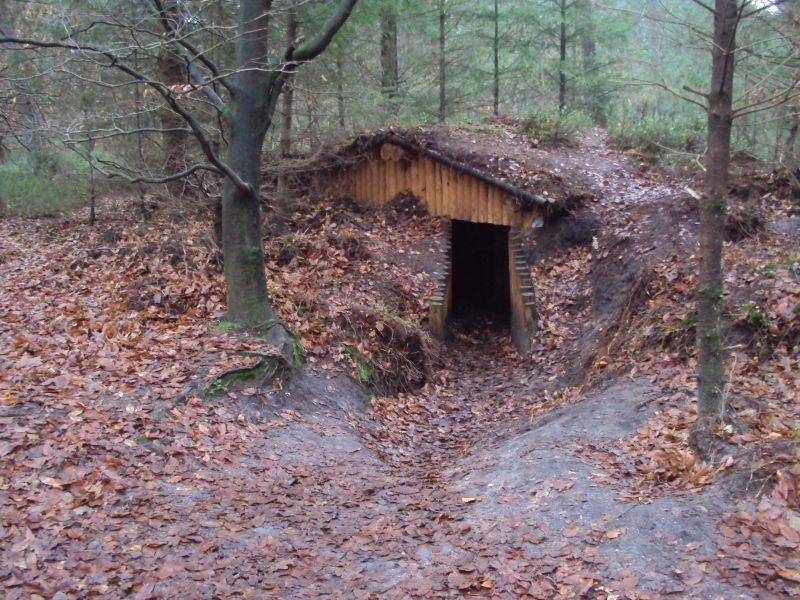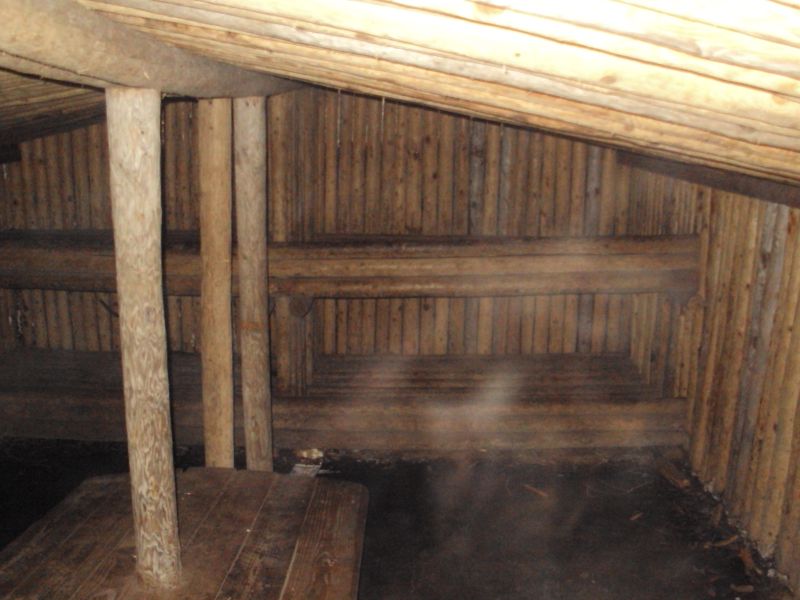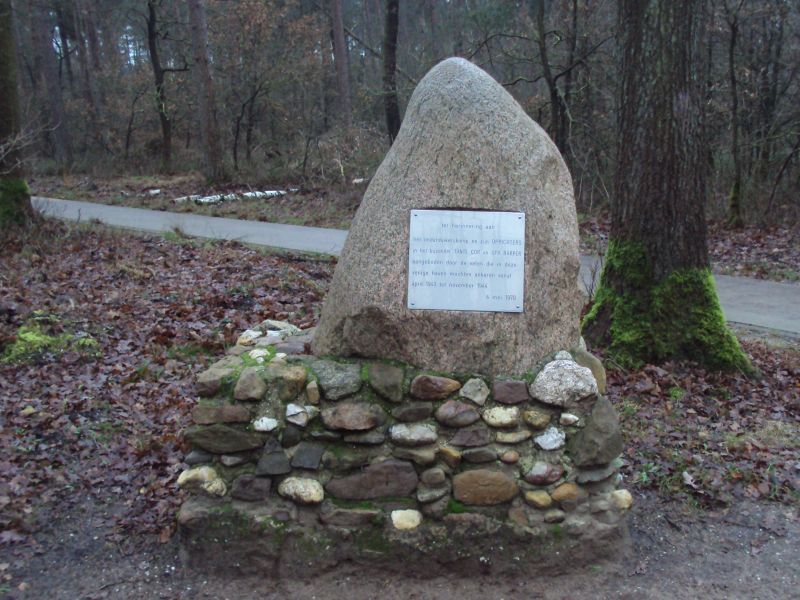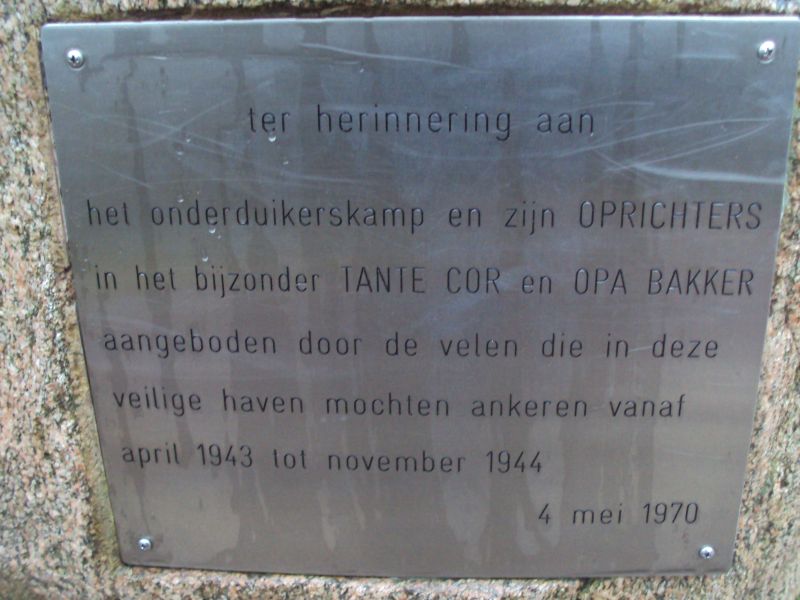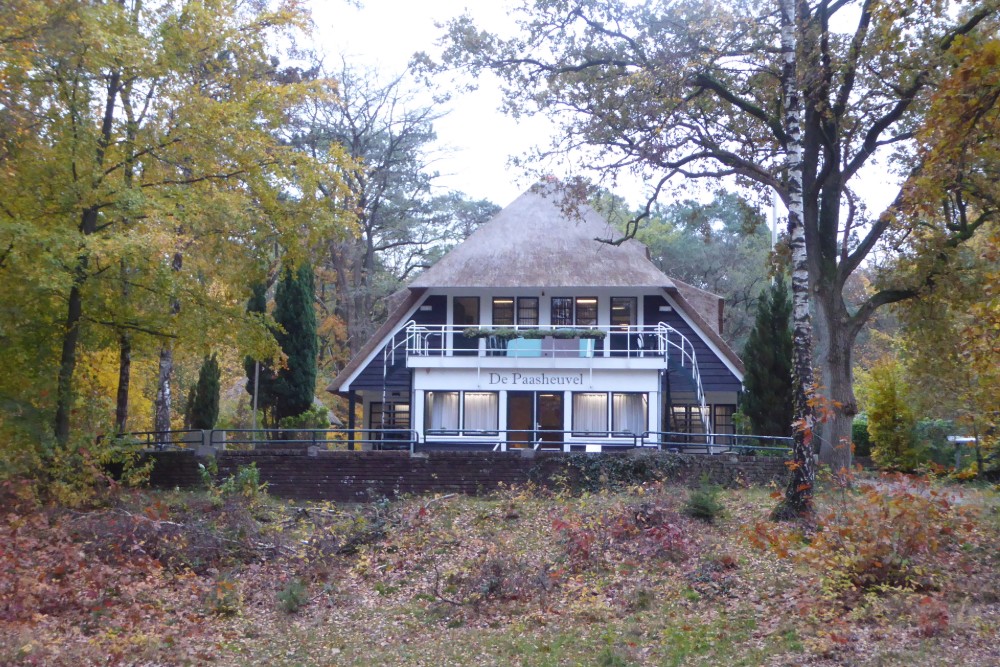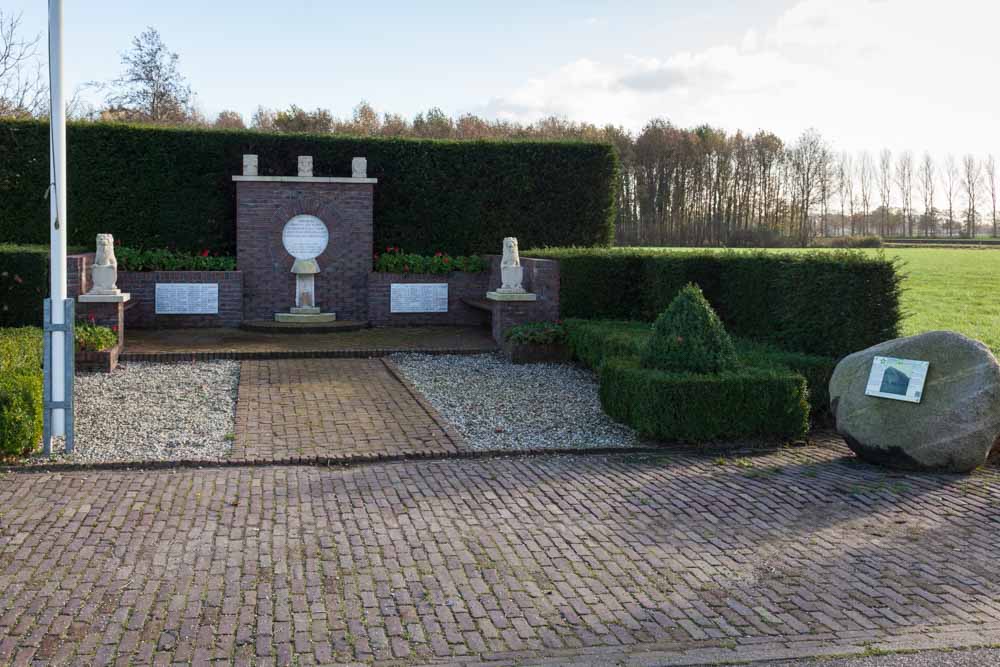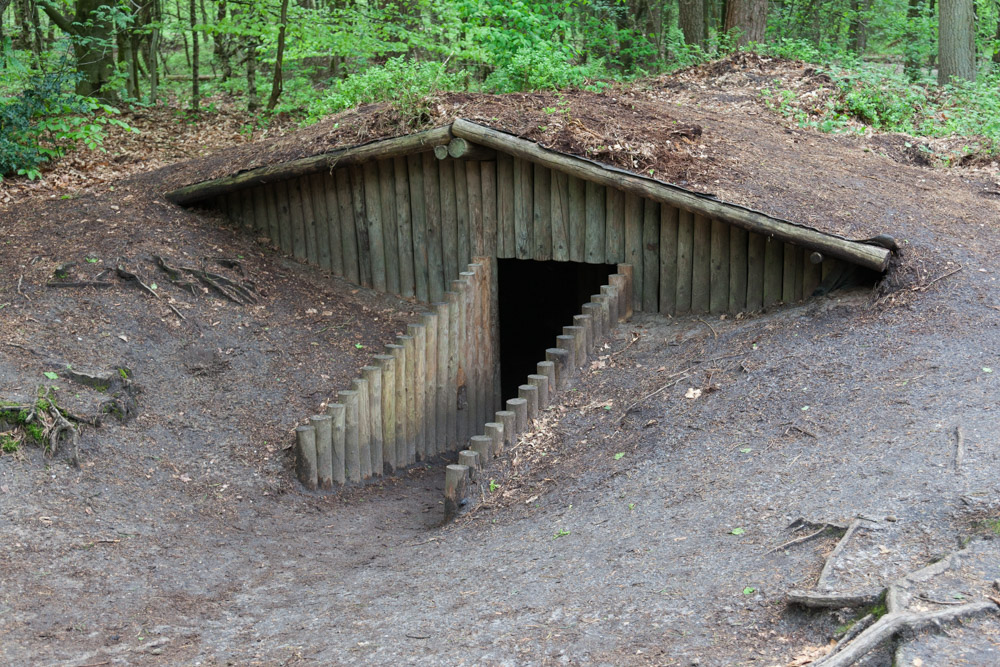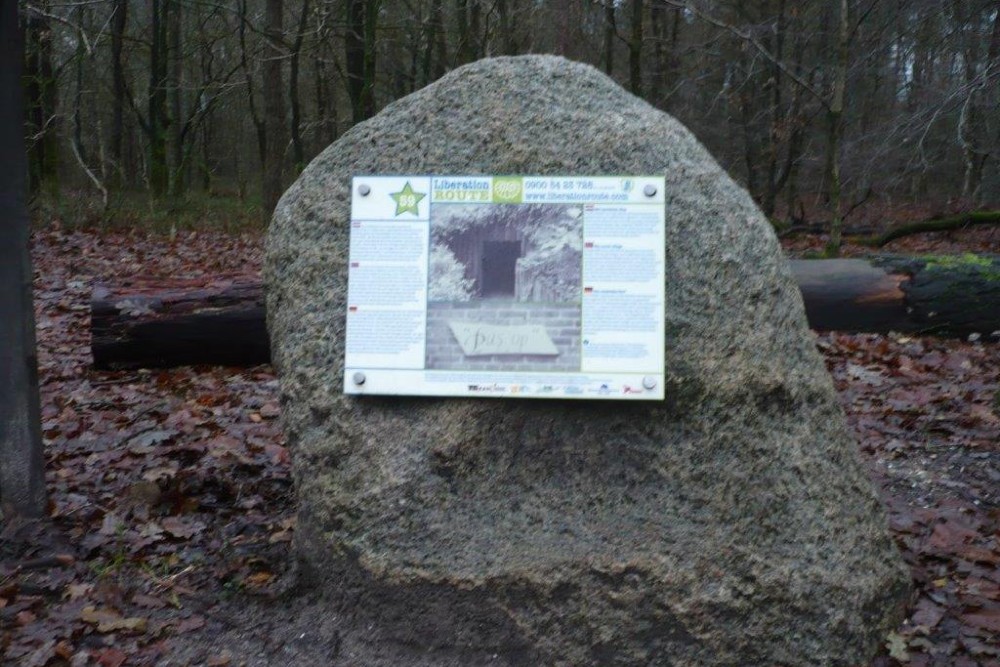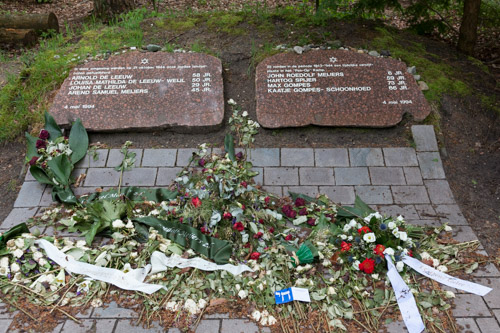Hidden Village of Vierhouten
The Hidden Village was founded at the beginning of 1943 on the Pas-op-weg (road) at Vierhouten on the North-Veluwe area (in the Netherlands) by the resistance worker Edouard von Baumhauer.
Owing to the increasing number of persons in hiding, the capacity for accommodating these people had nearly met its limits. The chance of being detected increased therefore. Edouard von Baumhauer, nicknamed "De Boem", (the bang) in cooperation with the Nunspeet couple Corry and Dionnysiu Bakker, nicknamed aunt Cor and granddad Bakker therefore founded the "Pas-op-camp" (be wary-camp) in the dense forests.
Von Baumhauer asked the farmer Karstens of the farm "Pas-op", situated at the edge of the forest, whether the shack behind the house of forester Schaarenburg could be used as a hiding place. Farmer Karsens agreed and approached the forester. Forester Schaarenburg however advised to move this shack to a spot in the middle of the forest. The edges of the forest were heavily patrolled by the Germans. It was no longer safe to hide a great number of people in this area. Further on in the forest were no German patrols. They were restricted to the edges of the forest, by way of tracks which were more or less accessible on foot or by vehicles.
At first the people in hiding lived in the canteen and in a tent, later on in primitive huts in the middle of the forest. The Pas-op-camp came into being. A total of twelve huts were built, some of them partly underground, others entirely above ground. The huts were situated in a very dense forest of young pines and were thus hidden from view.
The village population grew to more than a hundred people in hiding, among which were many Jews, but also a German deserter, shot down allied pilots, a Pole and a Russian. Today the Pas-op-camp is also called "Het Verscholen Dorp" (the Hidden Village).
Edouard von Baumhauer
During the Second World war Mr. (doctor juris) Edouard Henri von Baumhauer (1890-1950) and his wife Hermien von Baumhauer-Ribbink (1895-1986) played an important role in the resistance. Mr. Von Baumhauer was an independent lawyer with extensive contacts in the international business world. He also knew the fate of Jews and prisoners. Previously he had seen in Germany what the Jews befell and summoned them to emigrate. He himself did not escape imprisonment. In May 1942 he was arrested. He spent over half a year in the Sint-Michielsgestel prison. He was released at Christmas after his wife had approached contacts of her husband.
After his release Von Baumhauer went diligently to work, helping the people in hiding. Together with his wife he founded the Pas-op-camp for people in hiding in Vierhouten. With this initiative the Von Baumhauer couple saved, with the assistance of many resistance workers, scores of lives of people in hiding.
Supplies
From its inception in May 1943 a massive influx of both Jewish and non-Jewish refugees arose to the village. ‘Opa’ (granddad) en ‘Tante’ (aunt) Cor ran the coordination of the village. They provided supplies by collecting ration cards and to smuggle goods. The population participated in this.
Each hut was equipped with a box with information about the number of residents. According to those data ‘Aunt’ Cor tried to distribute the acquired goods as fair as possible. The goods were brought to the village by couriers. At the corner of the Pas-op road and the Tongerense road stood the house ‘Pas-op’, inhabited by the Vos family. The house ‘Pas-op’ (be wary) was situated along an ancient trade route, and owed its name to the warning for highwaymen who were once active there.
There was no access to drinking water. During the evening hours water supplies could be obtained at homes, situated at the edge of the wood. The house owners sympathised with the resistance. This obviously meant danger. It was not possible to warn the water bearers in time in case of danger. The occupants of the houses therefore devised a warning system. If the area was temporarily unsafe, they hung a piece of cloth on a tree. If the whole evening continued to be hazardous, they brought their watchdog outside. Once the dog gave tongue the people in hiding knew they had to return to the Hidden Village. Later on, the resistance installed a water pump nearer to the village.
Medical services
The residents of the Hidden Village did not have access to a sick-bay. Moreover, it was impossible to visit an infirmary in one of the neighbouring villages. However, in the Hidden Village lived two doctors, a Jewish medical student and a dentist. Huize Pas-op also had a treatment room for a dentist. Nonetheless it could not be prevented that people in hiding had to be transferred to a hospital. But an ambulance in the middle of the woods would of course arouse suspicion. People of the resistance therefore brought the patient on a stretcher to the Epenseweg, where an ambulance was waiting to deliver the patient at the hospital in Ermelo.
Hazards
Staying in the Hidden Village implied a great risk of being discovered. Rules were therefore drafted to avoid detection. The village consisted of four forest sections that were separated by firebreaks. During the day the residents were allowed to go out, but only in their own section and in absolute silence. Only in the dark they were allowed to enter another section to visit other huts or to fetch water at the pump.
Not all residents were able to adhere to this rule. Some of them got confused by constantly being in the same environment and with the same people. In addition, the liberation was still far away. Ze’ev Bar a surviving villager explained: I was a child and had to be quiet all the time and to whisper all day and to whisper is terrible for a child. Because to begin with you have to whisper, but also you cannot become angry and raise your voice.
So it was not surprising that tensions arose among residents. The constant strain and the living in close proximity to other people in the dense thicket gave some residents to so-called "boskolder", (wood staggers). They could no longer restrain their emotions and responded anxious, aggressive or in an exaggerated way.
To pass the time, there was a lot of pottering and reading. Meals were prepared and games played. Also children were taught by students. Leny Duyzend, a surviving resident, explains: "I cannot recall that I was bored, we had Ludo and that sort of things".
Since everything seemed to be going well, some people got careless with regard to the rules. The village residents already had had a narrow escape as in the spring of 1944 the village was nearly discovered. One of the resistance people had made a film of the daily life in the village. He kept this roll at home. During a search the Germans found this film roll and took it with them.
When the roll was confiscated, the village was immediately evacuated. The residents were taken to hiding places in the area by the resistance people. Four weeks later they were allowed to return. The film roll had been made unusable due to an error, which meant that the Germans could not see what was shown on the film. According to the official version of the story, a German investigating officer opened the box which contained the film outside a dark room. In another story the roll had been held in the light in an Arnhem laboratory after intervention of one of the contacts of "the Boem".
Discovery
On October 29th, 1944 the village was discovered. Two SS men who were out hunting, heard the noise of wood sawing and chopping in the forest. They turned to the direction from where the sound came and ran into a young resident, Ze’ev Bar: "suddenly there was a loud shouting "Raus du Jude, raus, raus" (out, you Jew, out)". The SS men fired some warning shots, which made it possible for a large group of residents to flee. The SS men released the boy in order to muster reinforcements from ´De paasheuvel´ at Vierhouten, where the Germans had their shelter. They expected to encounter a group of dangerous terrorists". After the discovery the Germans threw hand grenades into the huts and destroyed the whole village. Eight residents were taken prisoner and imprisoned in the basement of ´De Paasheuvel´.
One of them was Johnny Meyer; he was only just six years old. Two of the eight prisoners were executed at the foot of the ‘Paasheuvel’. On the 31st of October 1944, the others had to walk to the ‘Pas-Op-camp to be executed there. About a kilometre outside Vierhouten a conflict arose when two of the prisoners tried to escape. One was shot on flight, the other returned when his 6 year old son started screaming. Three holes were dug, wherein the prisoners were summoned to lie. Next they were shot. The six year old also did not escape this fate. On the place where they were executed a monument has been erected.
Edouard von Baumhauer had some fugitives prematurely placed elsewhere. Many people in hiding were able to reach safety and survived the war.
In memory
On the Tongerenseweg two memorials were unveiled on May 4, 1994 to commemorate the eight Jews who were discovered and killed.
Of the original huts is nothing left. In section 1, where the water pump was situated, three huts were rebuilt. The reconstructed huts were built in memory of the hundreds of people in hiding, including Jews, Allied pilots, a Russian and a Pole. The huts are maintained as a landmark. On the spot where the Hidden Village once stood, is now a memorial to commemorate the camp and its founders.
Opa (granddad) Bakker was arrested at February 1945 and executed on the 2nd of March, at Varsseveld, together with other resistance fighters. Tante (auntie) Cor survived the war. She died in 1989 and was buried in the presence of many.
In the spring of 1984 the Resistance Memorial Cross was awarded to Hermien von Baumhauer-Ribbink and her daughter Clazien (1923-1984). Her husband had survived the war but died nonetheless in 1950. Because of their aid to the Jews, Mr. and Mrs. Von Baumhauer were posthumously honoured in May 2000 with the Yad Vashem award. The Yad Vashem award is an honorary title given by Israel to non-Jews who hid Jews and helped them to escape and survive.
The Resistance Memorial Cross was also awarded to the many who supported the organization of The Hidden Village: C.D. Bakker, C.J. Bakker-van Rheenen, C. Karsten, J. Karsten-Rekers, A. Vos, A. Vos-van der Kolk, W. Wolffensperger, O.W. van der Linde, L.C. Schaarenburg, C. Mazier, I. Mazier-ter Velde, W. Mazier, M. Koster, W. Lindeboom, P. Doppenberg, G.J. ten Hoven, J.M. Vos, D. van den Bunte, J. Kattenburg, W. ter Flierbaar, J. Engel, G. Mulder, W. Westerhuis, E.J. Evers and others.
In 1987 the Hendriks family started an exhibition of old prints of Vierhouten and various other artefacts in their barn "De Ouwe Schuure" (the old barn). In 1991 this collection was expanded with a photo exhibition of the former camp in hiding. In 1993 the barn was given the status of museum. So, on Mai 5th 1993 the museum ‘The Hidden Village’ came into being. From 2000 until March 31 2012 the museum was established at the VVV (tourist information) at the Nunspeterweg. Shortly the museum will be housed in a new accommodation. Until that time the collection is stored in the archive basement of the town hall in Nunspeet. Meanwhile, the museum is located at Vierhouten in restaurant ‘the Vossenberg’.
Definitielijst
- Jews
- Middle Eastern people with own religion that lived in Palestine. They distinguished themselves by their strong monotheism and the strict observance of the Law and tradition. During World War 2 the Jewish people were ruthlessly persecuted and annihilated by the German Nazis. . An estimated 6,000,000 Jews were exterminated.
- resistance
- Resistance against the enemy. Often also with armed resources.
- Yad Vashem
- Yad Vashem is Israel’s national Holocaust memorial where in addition to Jewish victims and resistance heroes, also non-Jewish helpers of Jews during the World War 2 are being honoured. Those non-Jewish are called the Righteous Among The Nations. Until the mid 90’s trees were planted for these rescuers. In 1996 a special remembrance garden was established displaying all of the names of the helpers. Every year new names are added.
Images
Information
- Article by:
- Margriet Driessen
- Translated by:
- Cor Korpel
- Feedback?
- Send it!
Related sights
Sources
- WIELART, J., Route '40-'45, A.W. Bruna Uitgevers B.V., Utrecht, 2009.
Nationaal Archief, Inventaris van het archief van de familie von Baumhauer, 1513-2005 Staatsbosbeheer, Nunspeetse en Vierhoutense bossen, 2012, p. 6-9 - TracesofWar.com.
- Liberation Route
- GPSWalking.nl
- Nationaal Comité 4 en 5 mei
